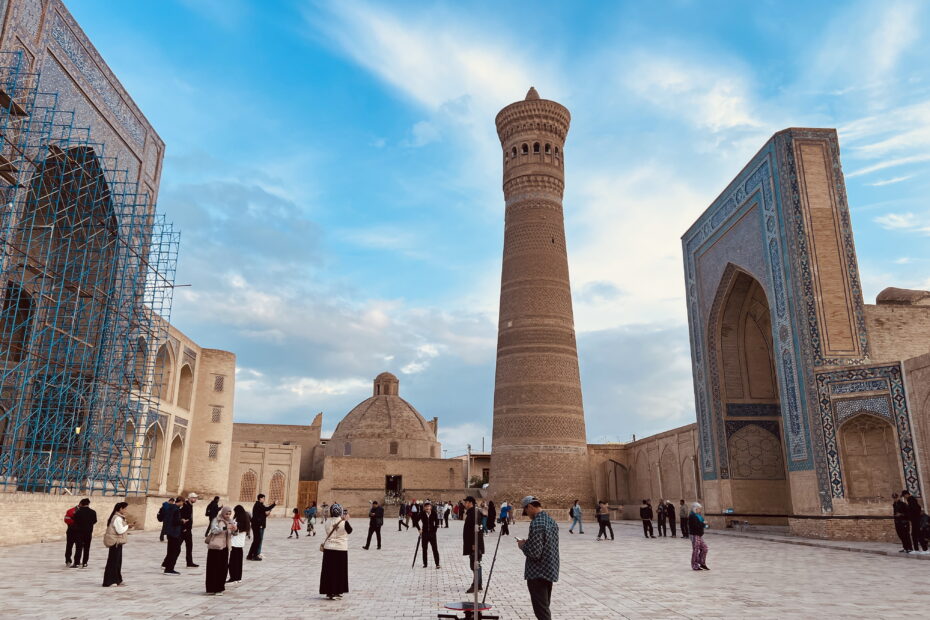In April 2025, Helle and Peter had 8 days Uzbekistan with Silk Road Cities and Hiking the Nuratau Mountains. Here we share our 8-day itinerary, including how we got around with a rental car, highlights of the Silk Road cities Samarkand and Bukhara, and our experience hiking with a guide in the Nuratau Mountains. We also share tips for eating vegetarian in a country known for its meat-heavy cuisine.
We had bought an Airalo eSIM in advance, but decided to also buy an Uztelecom SIM (3 euros). Uztelecom had the best coverage. We used Google maps for navigation. We rented a car from Sixt. You’ll find our experience renting a car and driving here.
Day 1 – Arrival in Samarkand: Mosques, Madrasas, and Markets
We landed in Samarkand in the early morning, groggy from our flight. After picking up a car from Sixt and a short drive to town, we had a nap at the friendly Hanifa Boutique Hotel, and chatted with Joseph and Ferdinand from the Philippines.


We first headed to the legendary and very picturesque Registan Square, flanked by its three grand madrasas: Ulug Beg (1417-1420), Sher Dor (1619-1636), and Tilla Kari (1646-1660). The blue tiles, intricate woodwork, and especially the golden interior of Sher Dor was amazing, even on an overcast day.
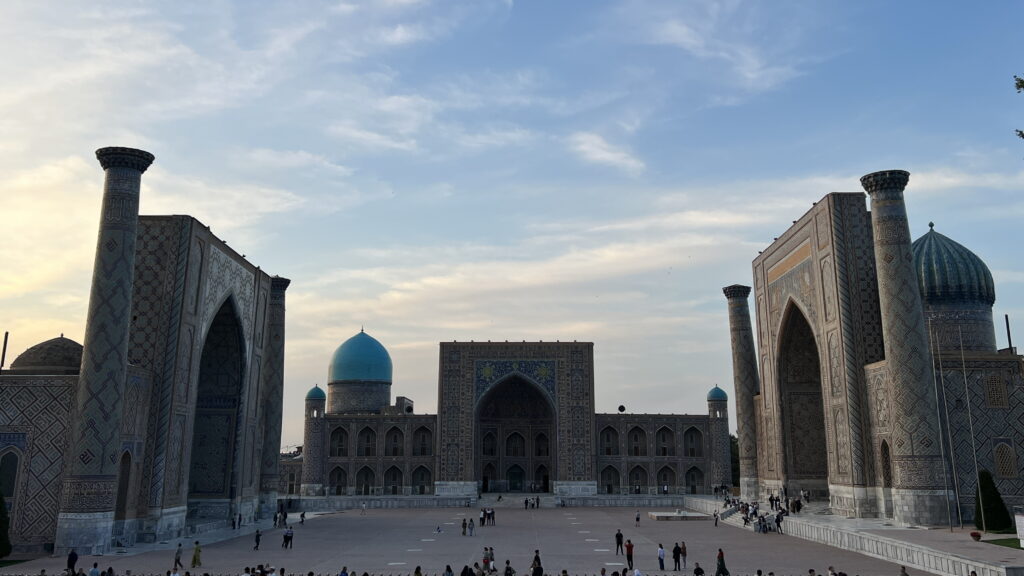
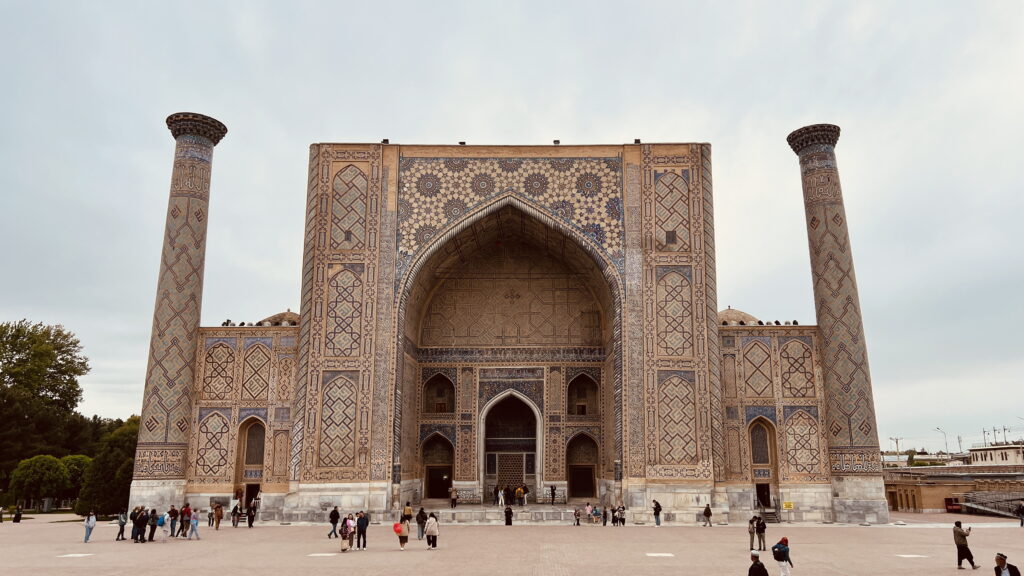

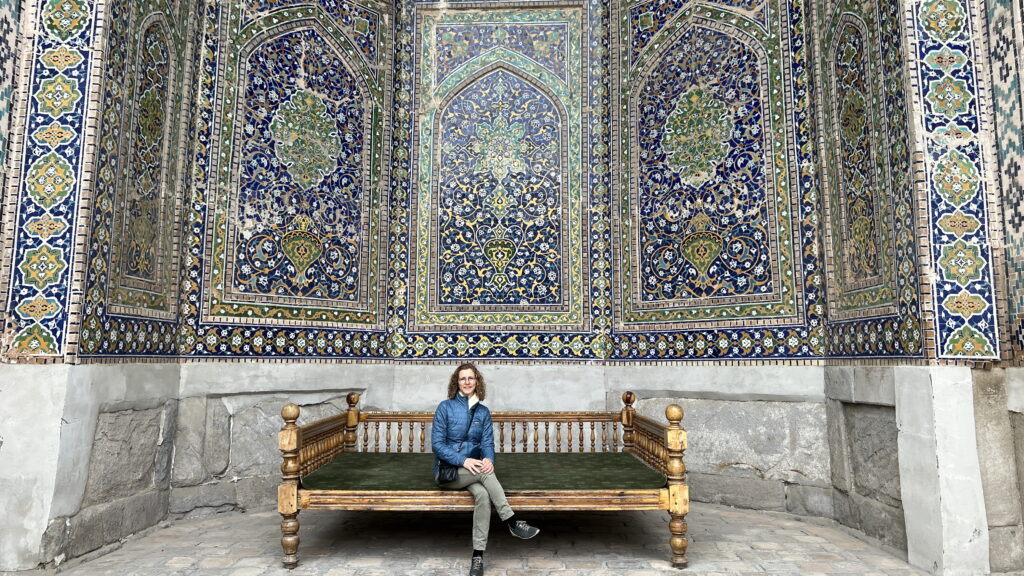
From there, we strolled the pedestrian-friendly street to Bibi Khanym Mosque (1399-1404), built by Emir Timur’s wife. Emir Timur is a national hero in Uzbekistan.
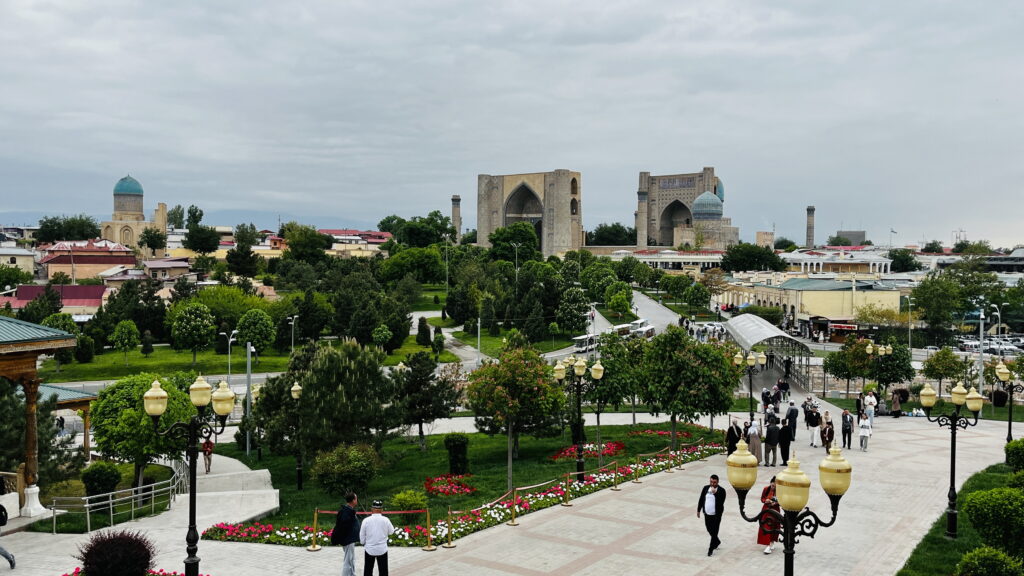
Almost every culturally significant building in Samarkand is decorated with blue tiles, mosaics, and glazing. The shades range from deep royal blue to bright turquoise. The color blue has historical and spiritual significance—it was associated with nomadic traditions, and later symbolized the heavens in Islamic architecture.
The tiles were made from ceramic, primarily using quartz powder mixed with metal oxides to achieve the vibrant blue hues. Cobalt was used to create the deep blue color, sourced from far-away regions like Thuringia and Saxony.
Samarkand was the capital of the Timurid Empire. Its ruler, Emir Timur, conquered a large territory spanning across Central Asia, Iran, Turkey, Syria and northern India.
Emir Timur wanted to transform Samarkand into the most magnificent city in the world, so he commissioned the construction as a testimony to his wealth and power. He forcibly relocated experts in tile-making, calligraphy, and construction from the places he conquered. These craftsmen had little choice in the matter—many were taken as captives and ordered to work on Timur’s grand architectural projects.
Today we can admire the results of their labor.
The weather turned from overcast to rain, so we found shelter in the roofed bazar shopping nuts, halava and a beautiful, handmade scarf. The bazar is a treat for the eye with all the colors and a good place to chat with the locals. Many people in the bazar spoke English.
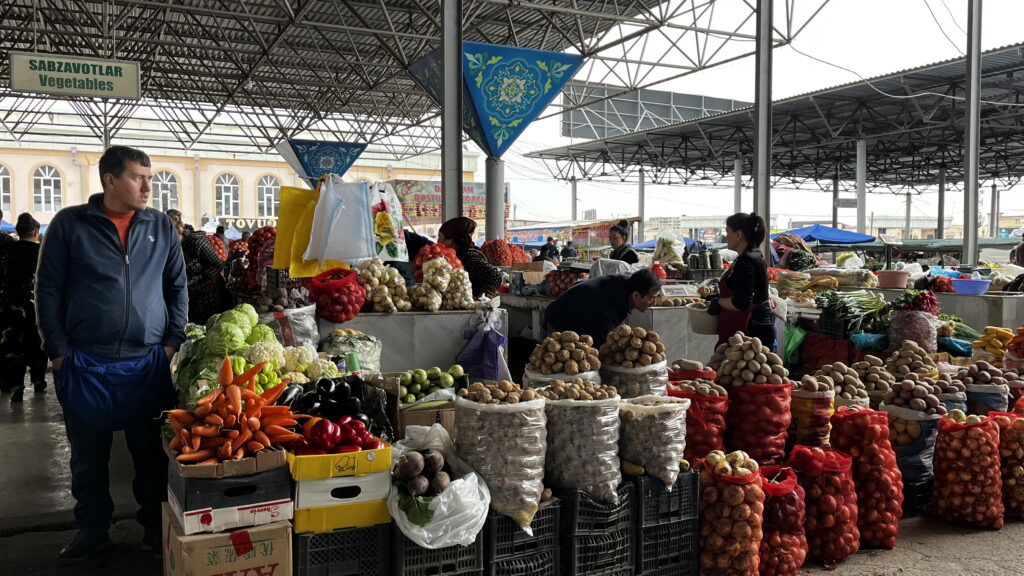

We had a nice dinner at Emirhan restaurant.
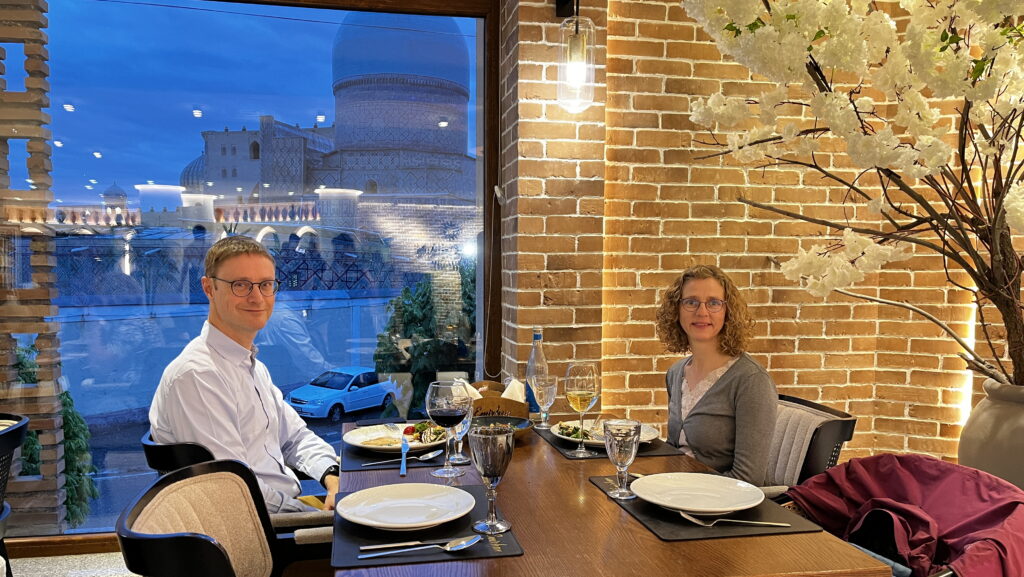
After dinner, we walked by the Registan square to see the evening light show.

Day 2: Samarkand to Bukhara
It was raining when we left Samarkand, but we had 5 1/2 hours drive to Bukhara, so it didn’t matter too much.
Instead of driving the shortest route, we drove further south and stopped in Qarshi to see the old Persian Qarsi Bridge over Kashkadarya River and the Kok Gumbaz Mosque, both from the 16th century.
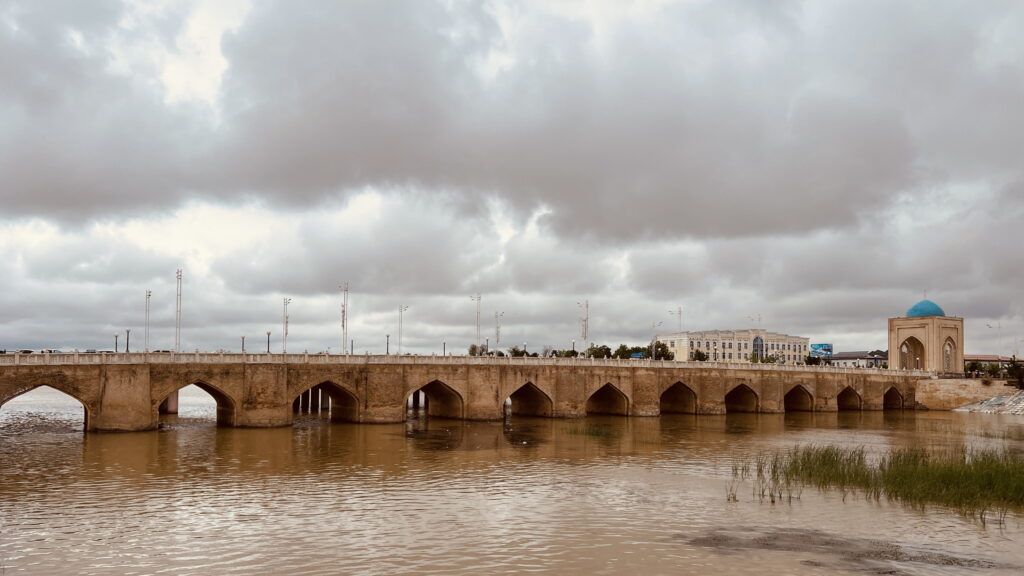
In Pudina we visited the Khasim Ata Mosque Complex from the 11th century. We were now in rural Uzbekistan and the caretaker didn’t speak English. He was very welcoming and wanted to tell us about the mosque. All that we managed was to explain that we were Danish.

Peter needed a coffee, so we stopped at a restaurant that caught the eye with full-size figures from Shrek at the roadside. Communication was extremely difficult and even Google Translate turned into nonsense. We thought we ordered coffee and tea, but we got a bread instead. The staff was clearly as confused as us.
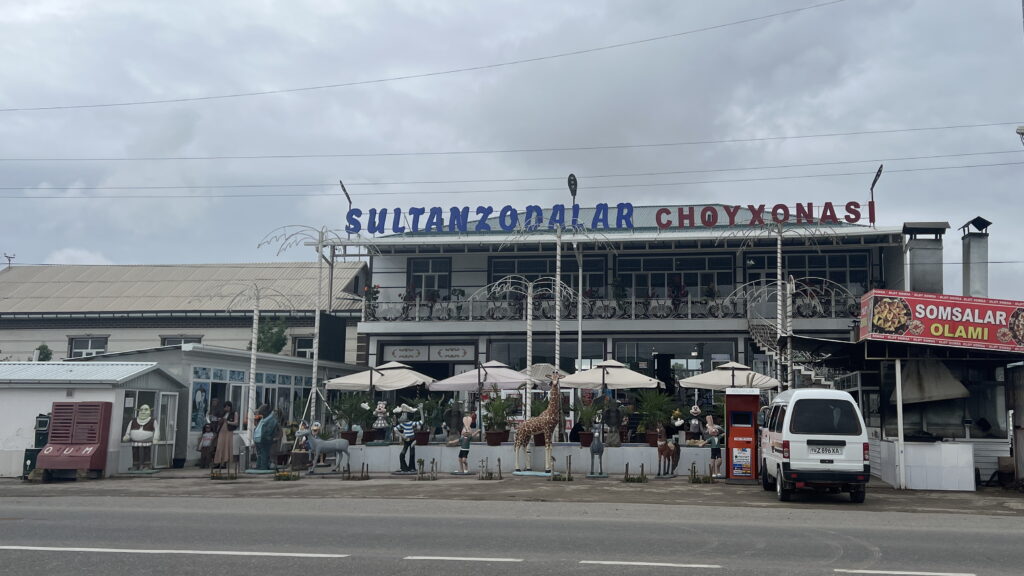
We arrived in Bukhara in the afternoon and took an easy stroll around the beautiful old city. Bukhara is packed with souvenir shops and tourists, but it was very cozy to wander around and we enjoyed all the amazing old buildings.
Bukhara is like walking in a film set for the quintessential Silk Road city. Marco Polo could be just around the corner. But no, it is one of the many other tourists that come for the same reasons as us. The city is heavily restored, but the charm is intact. And there is space for all of us.
For dinner at Minzifa, we tried several local specialties, which were tasty and served beautifully. We stayed at the charming but pricy Kukaldosh Boutique Hotel.

Day 3 – Treasures of Bukhara
We woke up to a clear blue sky and were ready to explore the wonders of Bukhara. The entire old town is a pedestrian area and it makes it very comfortable to walk around the city.
We started at Chor Minor Madrasa (from 1807), built by the Turkmen merchant Kalif Niyazkul with inspiration from Hyderabad, India. It is said that the four towers represent each of his daughters.
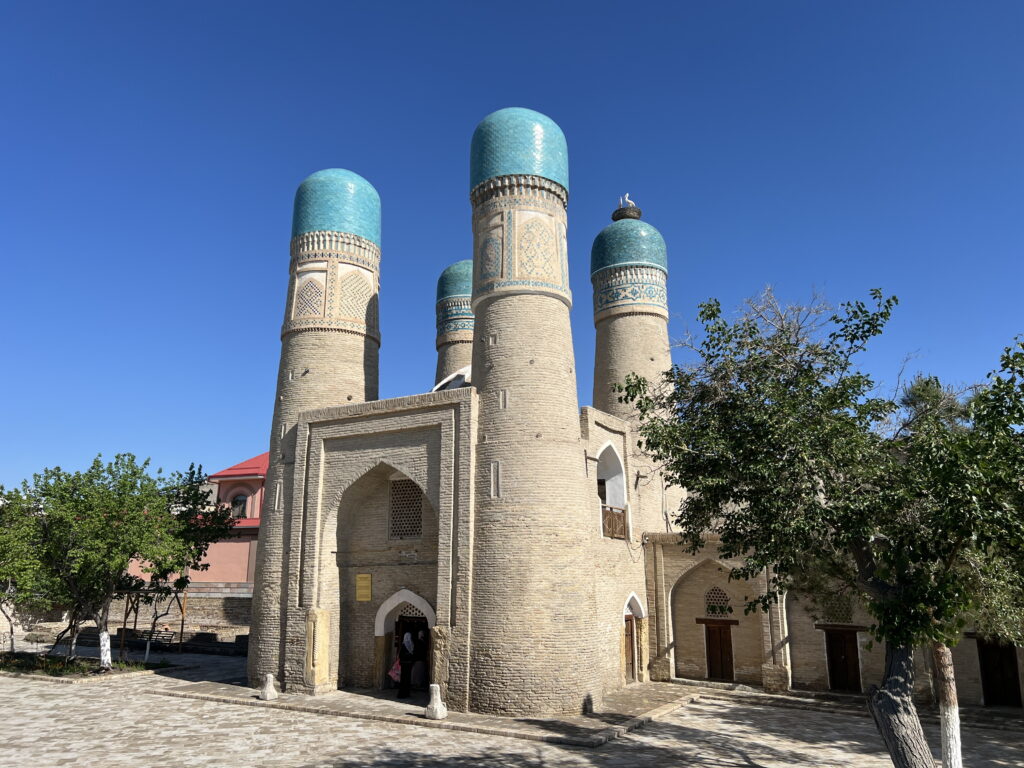
The oldest Madrasa in town is Ulug Beg from 1417 built, by the grandson of Emir Timur. Ulug Beg was a king, but he spent most most of his time studying astronomy. He managed to calculate the exact duration of a year, as well as the tilt of the earth. At the facade of the madrassah, surah 67 of the quran is written. It underlines the duty of pursuing knowledge.
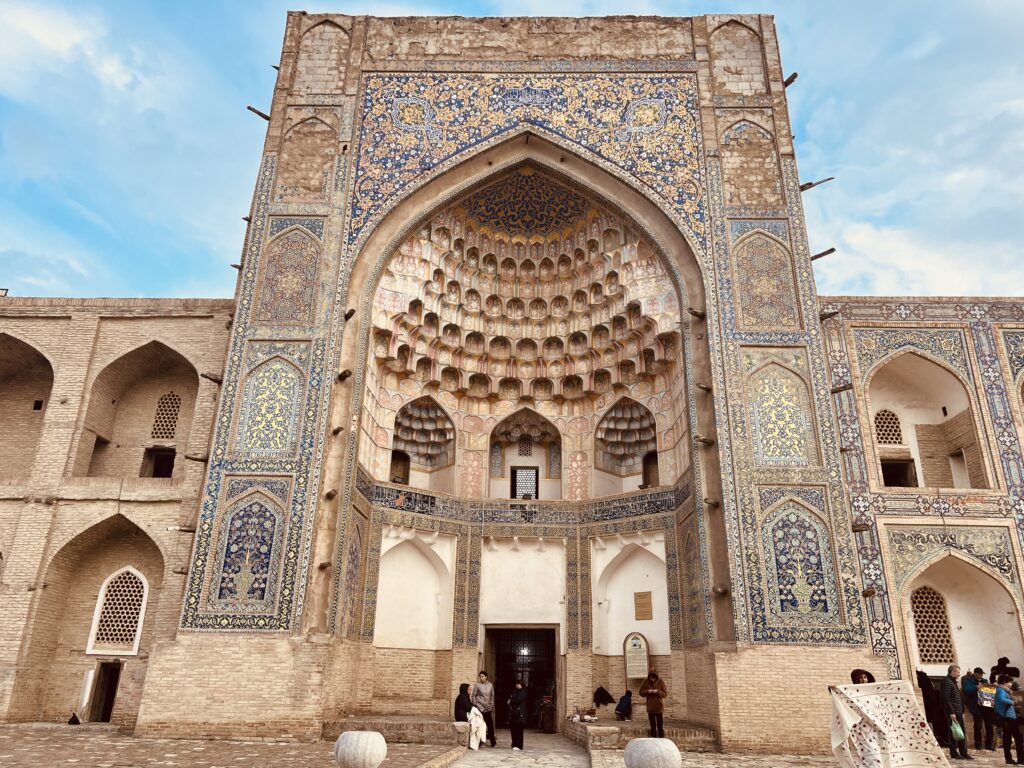
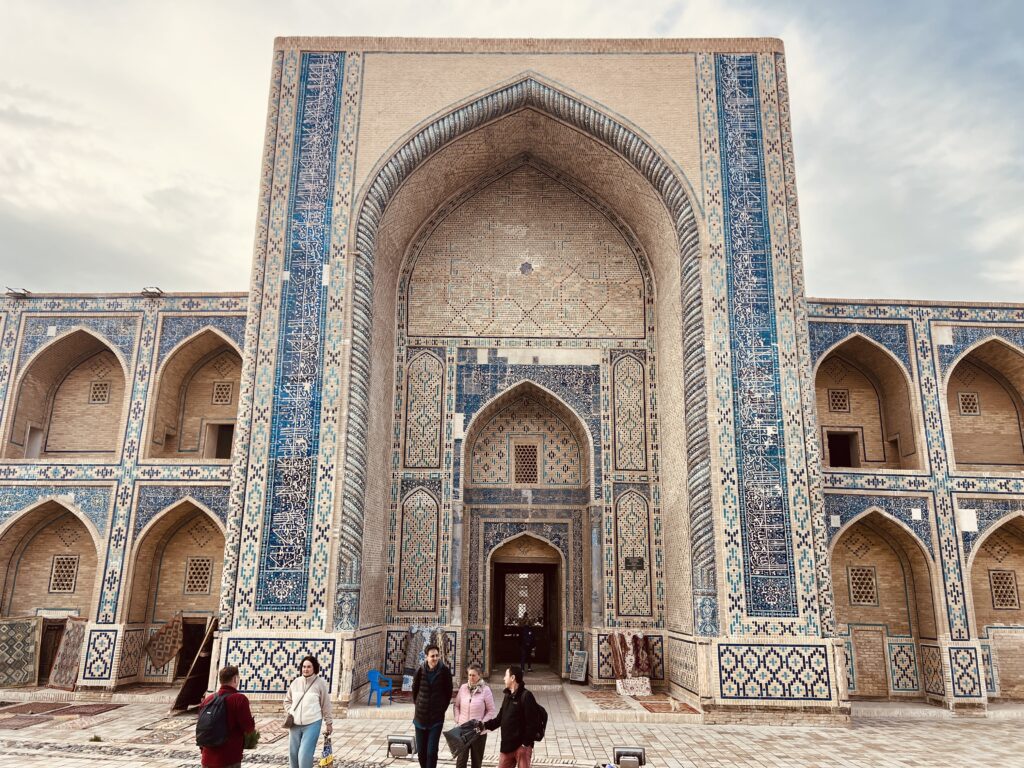


Bukhara has been the most important city on the Silk Road and was attacked in 999 by the Karakhanids, in 1141 by the Karakhitai, in 1206 by the Khorezmshah and in 1220 by Genghis Khan. Genghis Khan slaughtered all inhabitants and tore the city apart. It took almost 300 years to rebuild the city, and around 1500 AD it reached a new pinnacle with 150 madrasas and 300 mosques.
The heart of the city is Poi Kalyon Square with Kalyon Minaret, which was the highest tower in the world when it was build. Beyond the use as minaret, it was also used to throw prisoners to their death as punishment. Kalyon Mosque and Mir-i Arab Madrasa face each other at Poi Kalyon Square, and both are still in use today.


There are shops everywhere, and they all sell similar items. We decided to buy a beautiful silk carpet from the aptly named shop Magic Carpet.

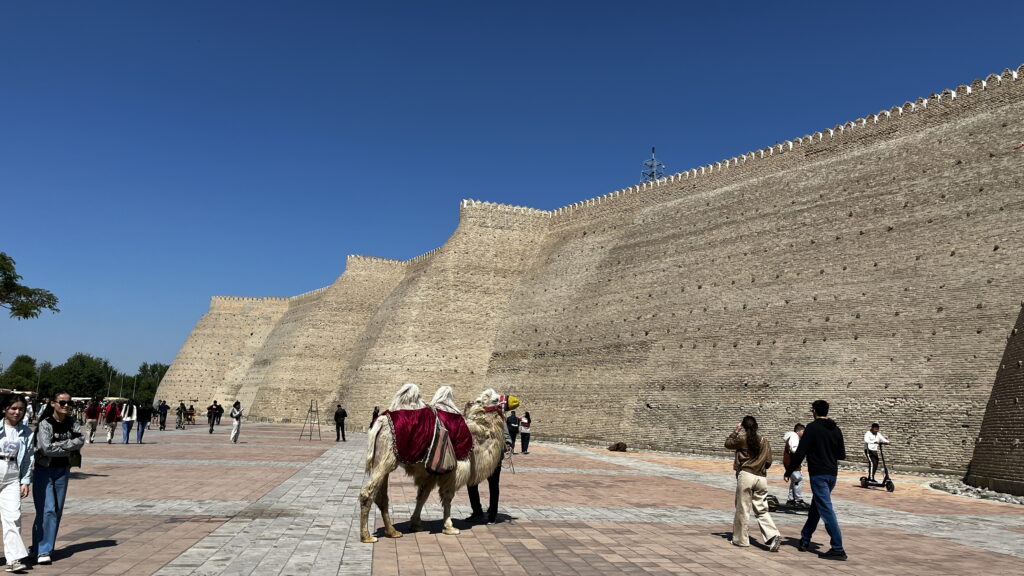
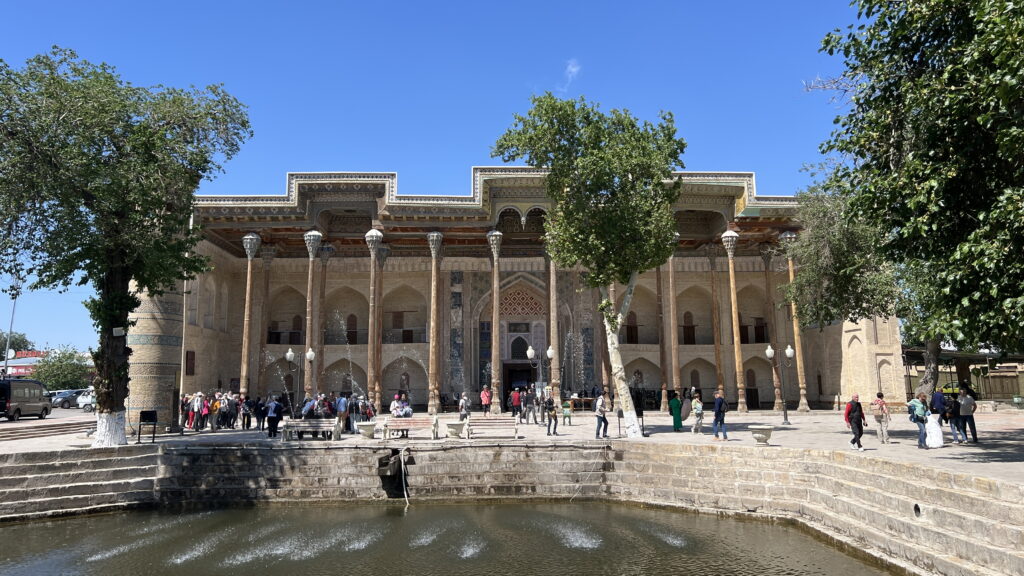
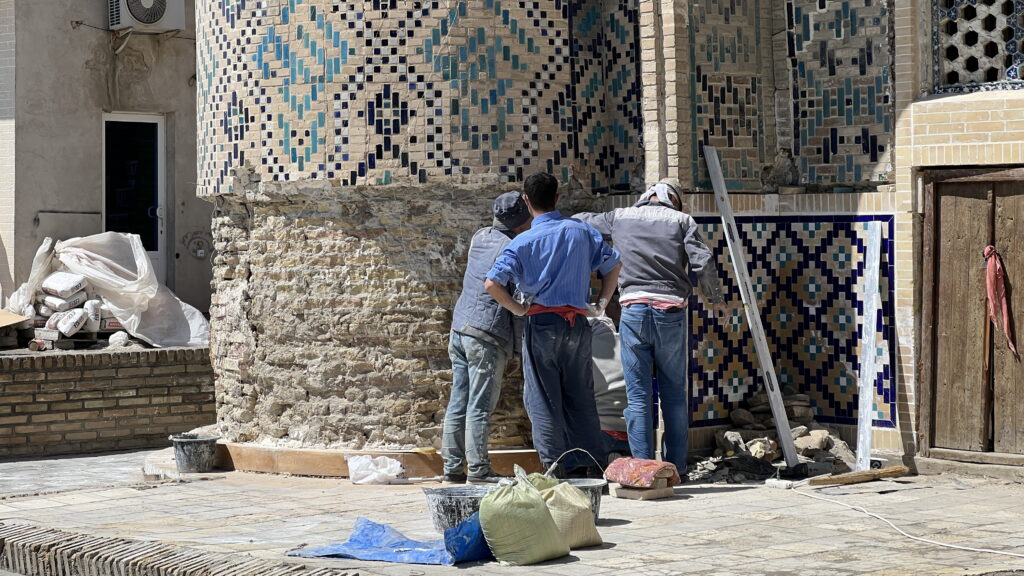
Most of the other tourists were central Asian, and many were Uzbek. It was a Sunday, and it seemed that many used the day to stroll and relax in Bukhara.

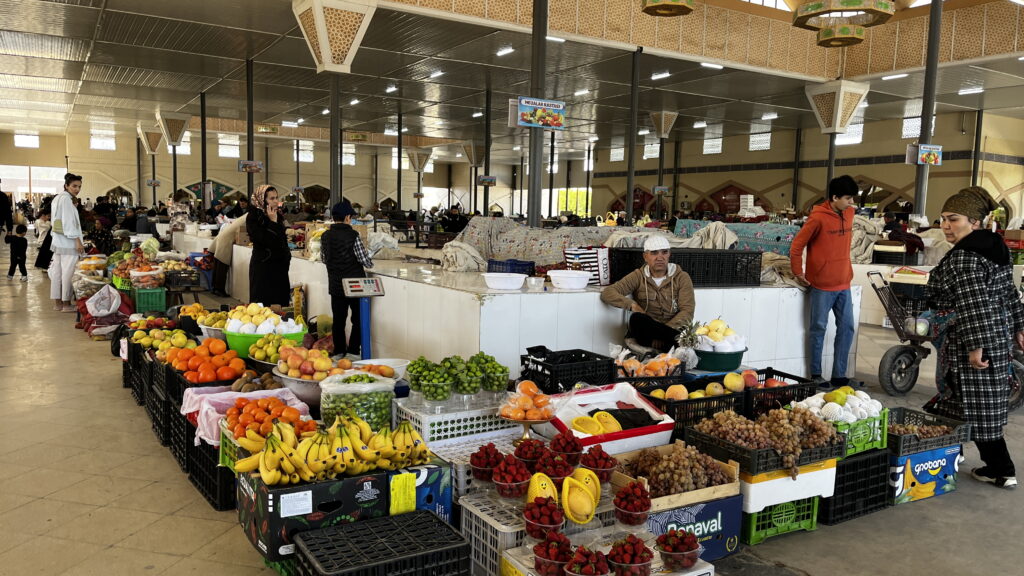
The popular restaurants require reservations days in advance. We had a reservation for Ayvan, where we had pike in a very beautiful 1800-hundreds restaurant. It was a warm evening, and we had a glass of wine afterwards outdoor at one of many cafes by the fountain on Lyabi Hauze.
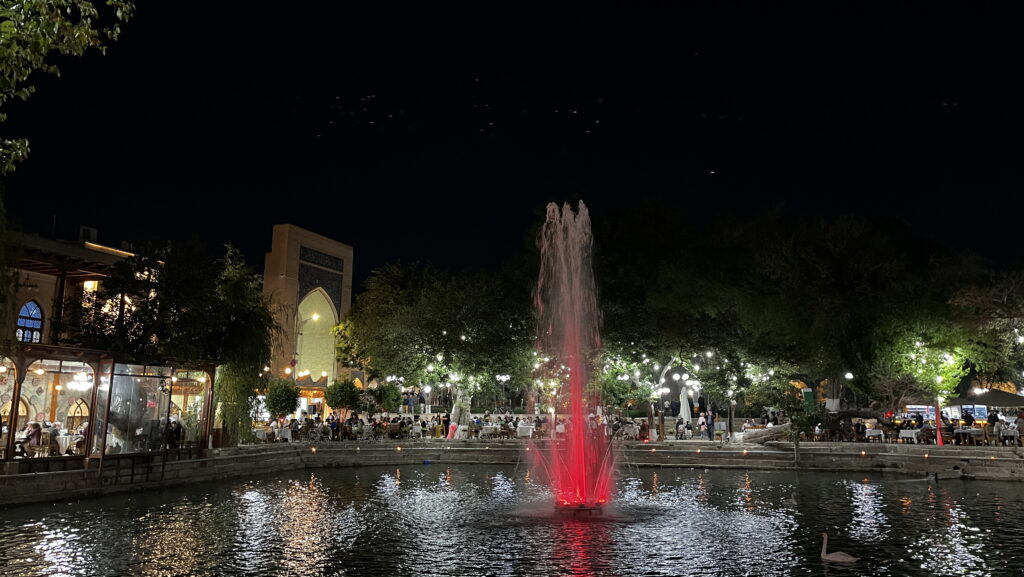
Day 4 – Pottery and petroglyphs on the road to the Kyzylkum desert
Gjiduvan is famous for ceramics, and we visited a traditional factory and learned about the process. The pottery is owned by the 8th generation of the family and still uses the traditional methods. The grinder for the glaze is still driven by donkeys.
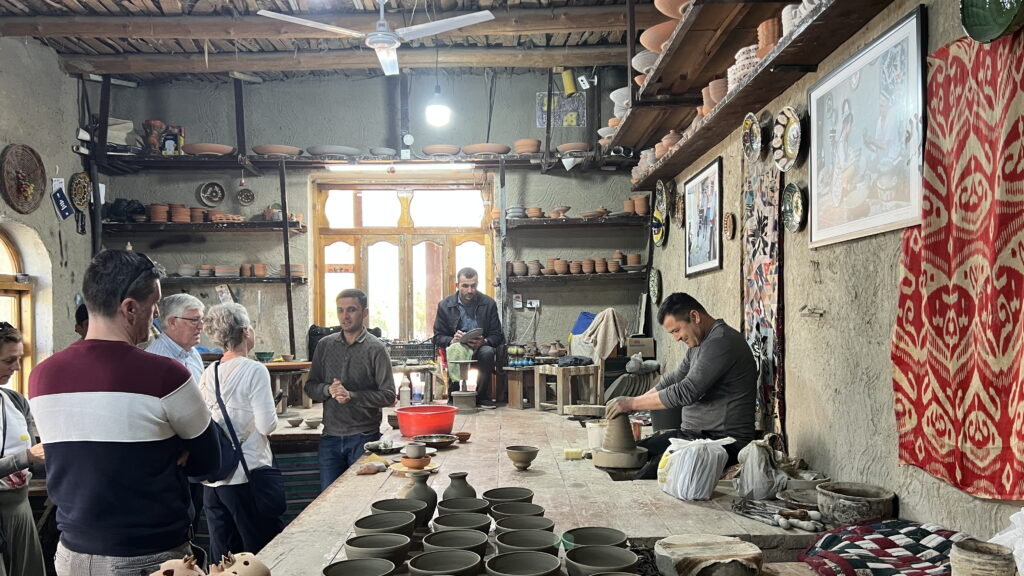
We briefly stopped en route to see the Mir-sayid Bakhrom Mausoleum and the Rabati Malik caravanserai.
From here we took a detour to the Petroglyphs National Park in Sarmysh canyon. It turned out to be a picknick spot for Uzbeks with loud music and barbecue. Many families wanted to talk to us, but with our limited Russian we felt frustrated. We were offered to have picnic with the families, but we still had several hours of driving to our yurt camp, so we had to move on. We would have loved to linger around. We left with bread and fresh mint given to us by the Uzbek families.

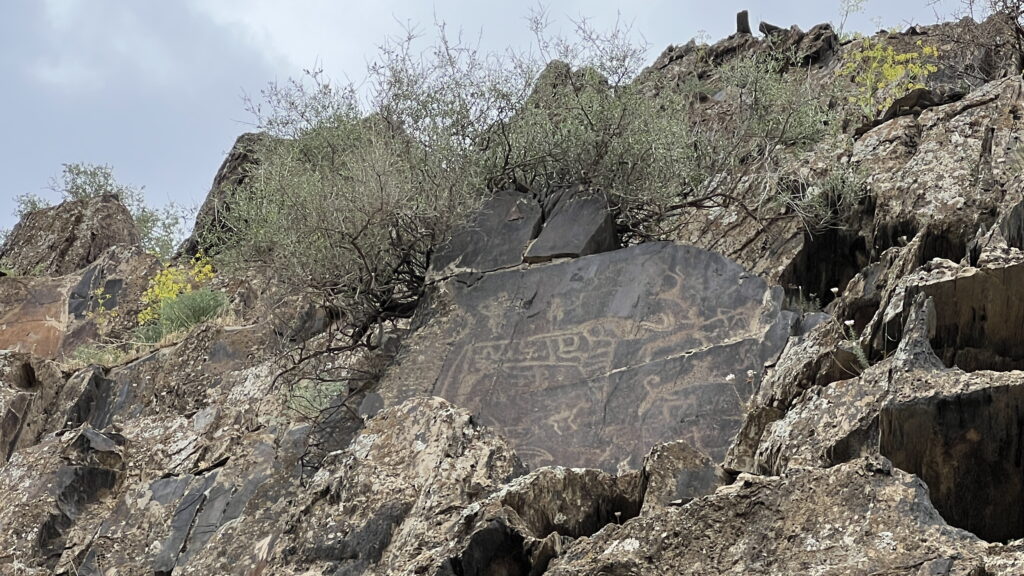

In Nurata we had a short stop at the Nur fortress build by Alexander the Great.
We arrived at Beruniy yurt camp in Kyzylkum dessert in the evening. Aziz instantly made us feel at home. He showed us photos from his hunting and fishing trips, and made dinner for us and the four other guests.
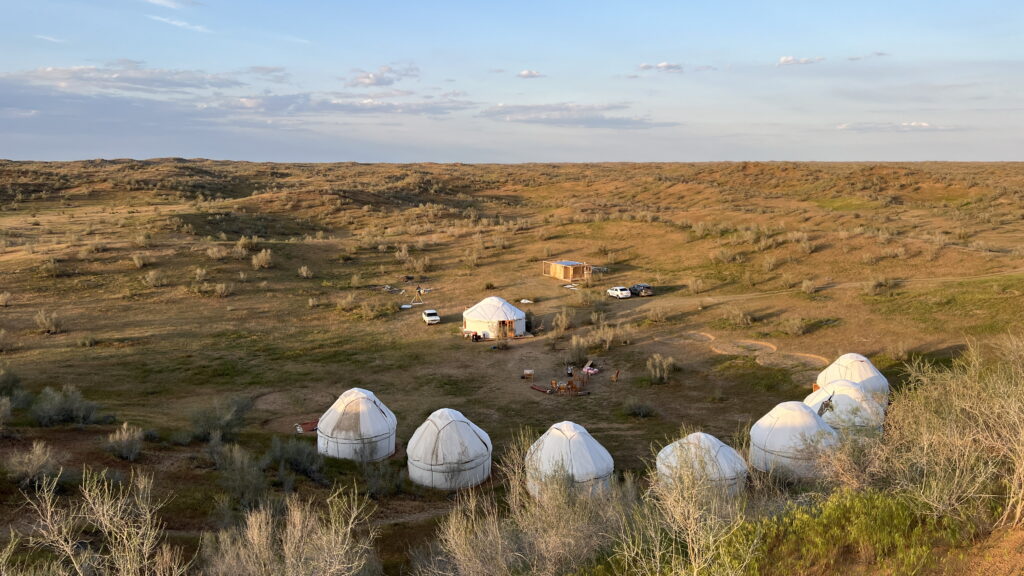
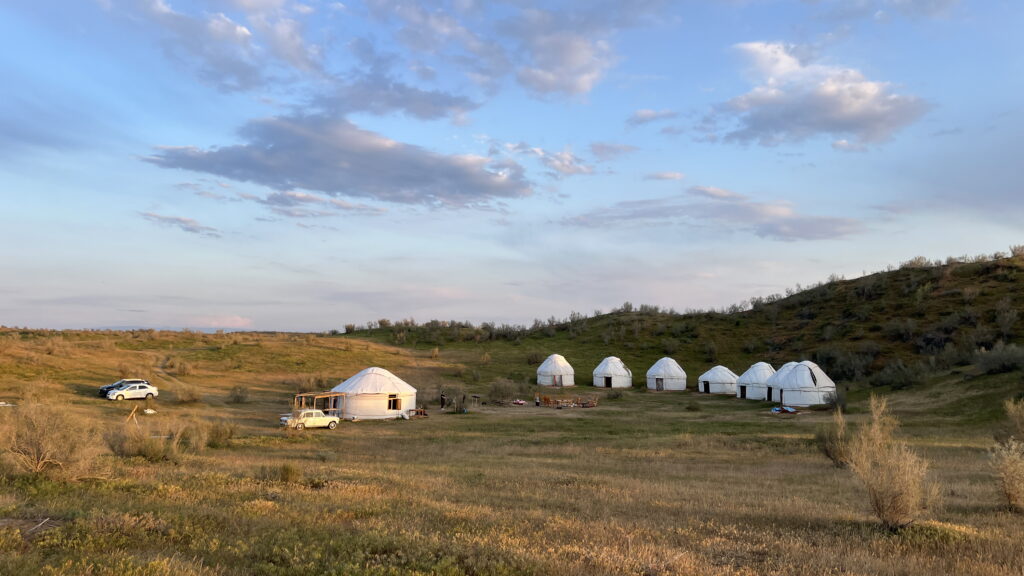

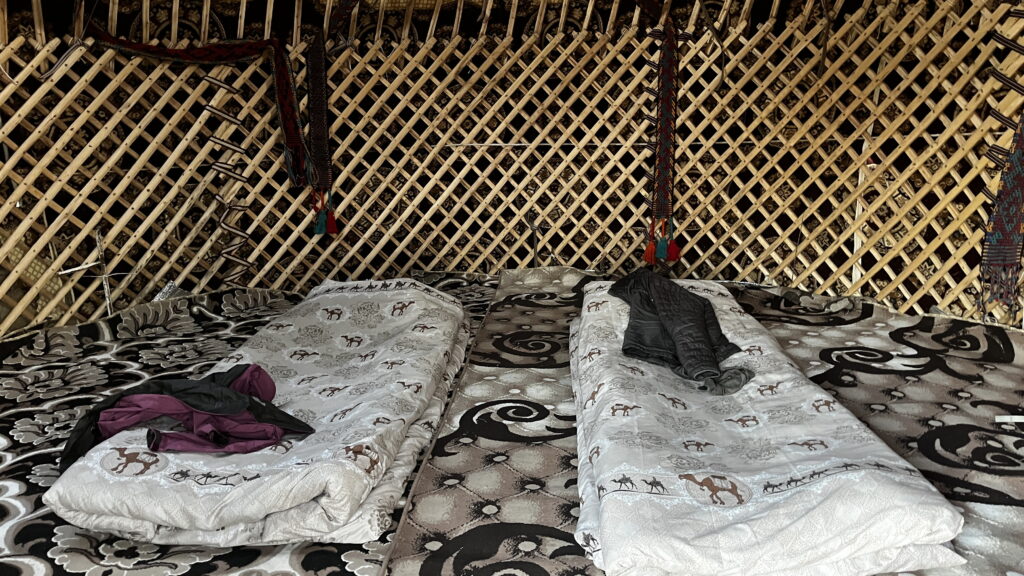
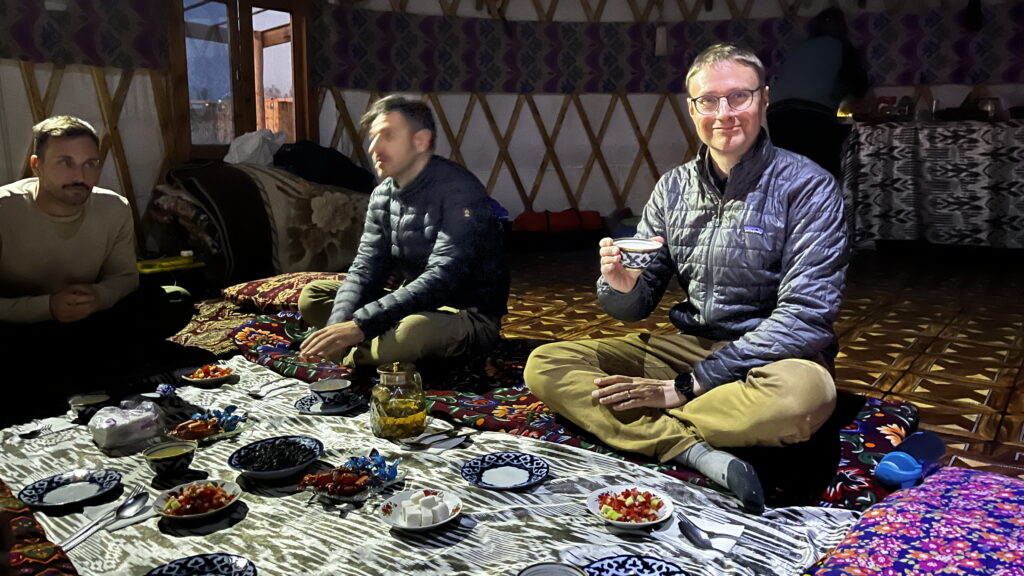
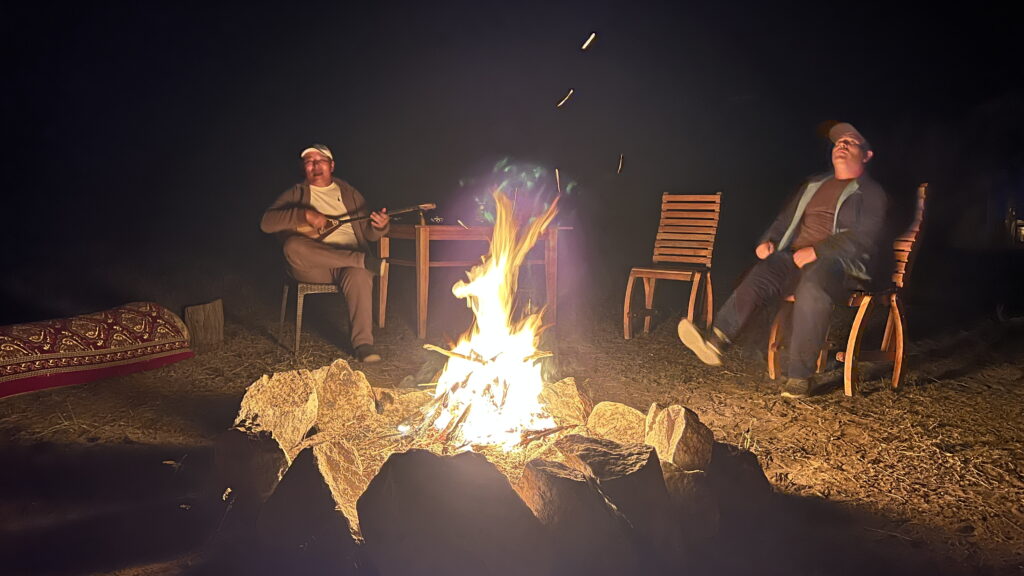
It was a quiet afternoon and evening at the camp, with no wind and the stillness of the desert. After dark we could see millions of stars.
We had a campfire and traditional music was played. After spending time in cities this was just what we needed.
Day 5 – Aydar Kol Lake and the Nuratau Mountains
After a cold night, we woke up to a clear blue sky visible through the roof of the yurt. The thick blankets had kept us warm, and already for breakfast at 8:00 the day started to warm.
Beruniy yurt camp is just north of the artificial Aydar kol Lake, so this was a natural place to go. We followed Aziz to a viewpoint, driving thorough loose sand to get there.
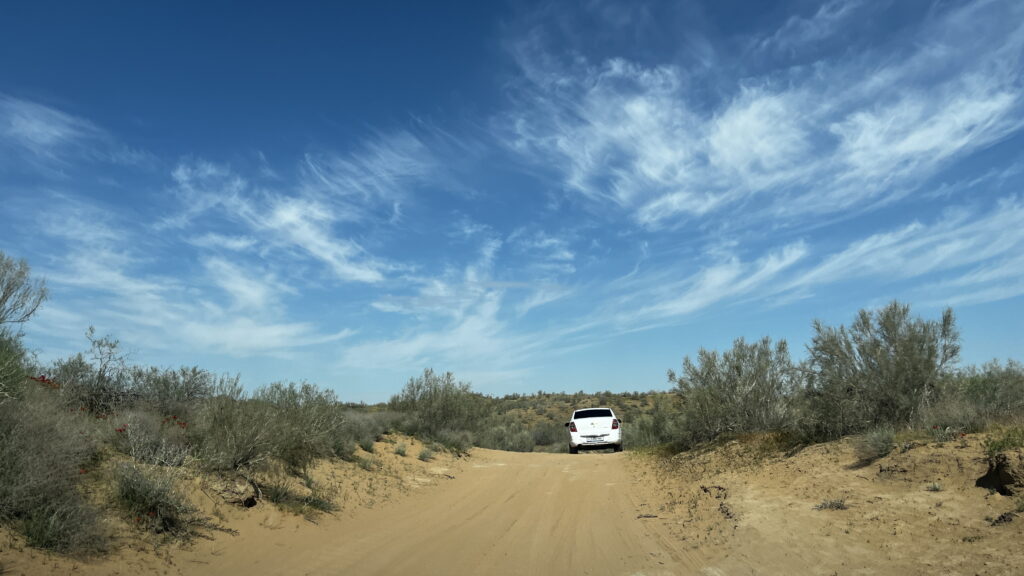
It was difficult to find a beach where it was possible to swim. All beaches on the map were on private property behind fenced gates. We finally found a gate where we were allowed to enter (with payment). It was a Soviet resort that had fallen into disrepair. The beach was nice and Helle had a swim in the not so cold water.
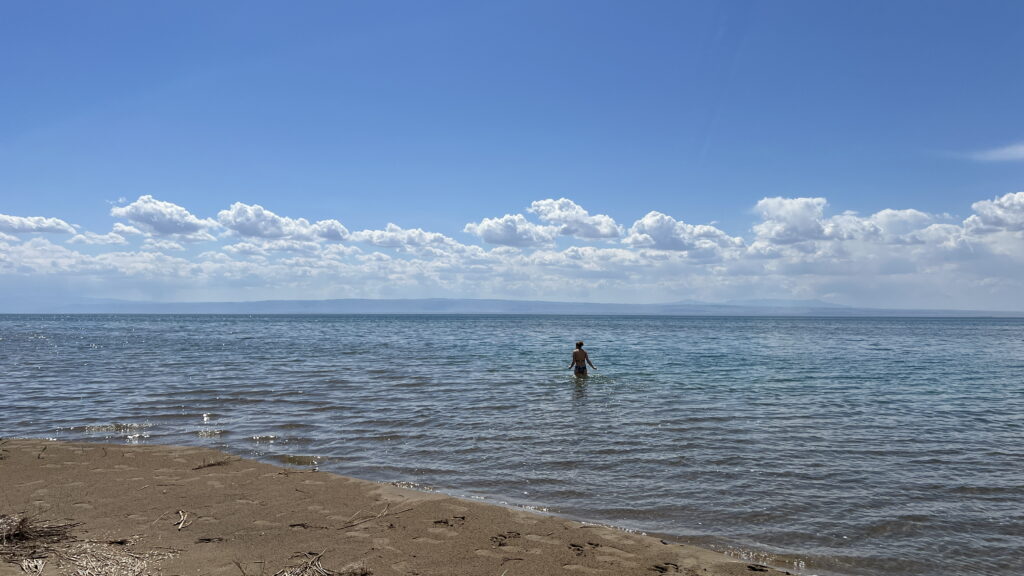
From the lake we had a two-hour drive to Asraf village in the Nuratau Mountains. We were going hiking with a guide from Nuratau travel. According to the plan, we parked our car at a guest house and were driven to Hayat village by the guesthouse owner. From Hayat we would use the following two days to hike back to our car in Asraf.
We were invited to an amazing lunch at Muso Baraka Nur guesthouse with Shodmon (the owner) and his father.

After lunch we took a walk around the village and further into the mountains with Tom and Rachel, two other guests. Shodmon’s father rode up on his horse to guide us back.


The guesthouse was a true paradise. The owners were friendly and hospitable, and the food was the best we had had so far. The guesthouse was run by a family, and it was good to see how they treated each other with kindness and love.
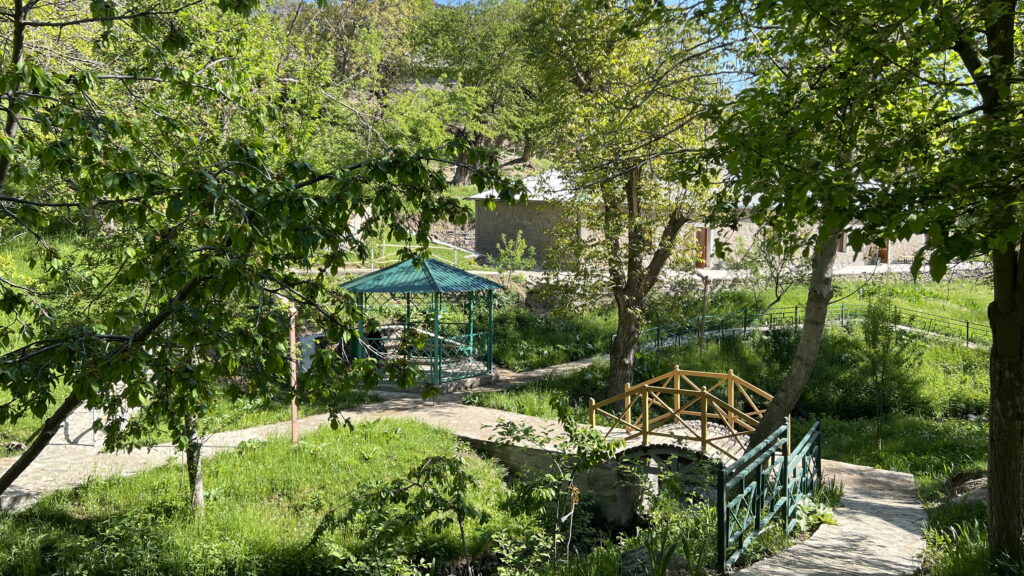
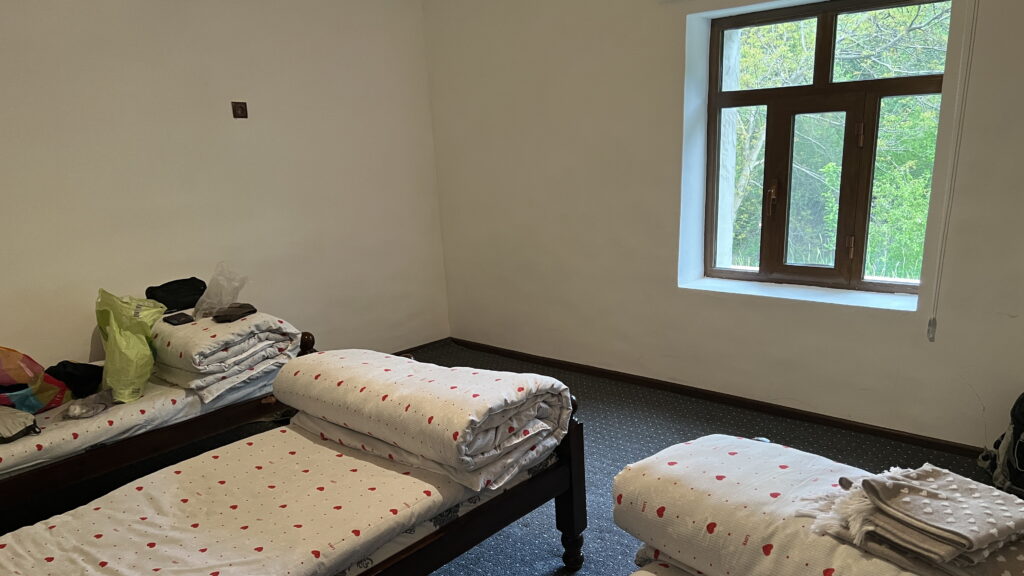
Day 6 – Hiking from Hayat to Uhum village
We had a delicious breakfast under the tress of the guesthouse’s fruit garden. They had walnuts, mulberries, apple, apricot and many others. Much of the food served came from the garden, and they took well-deserved pride in this.
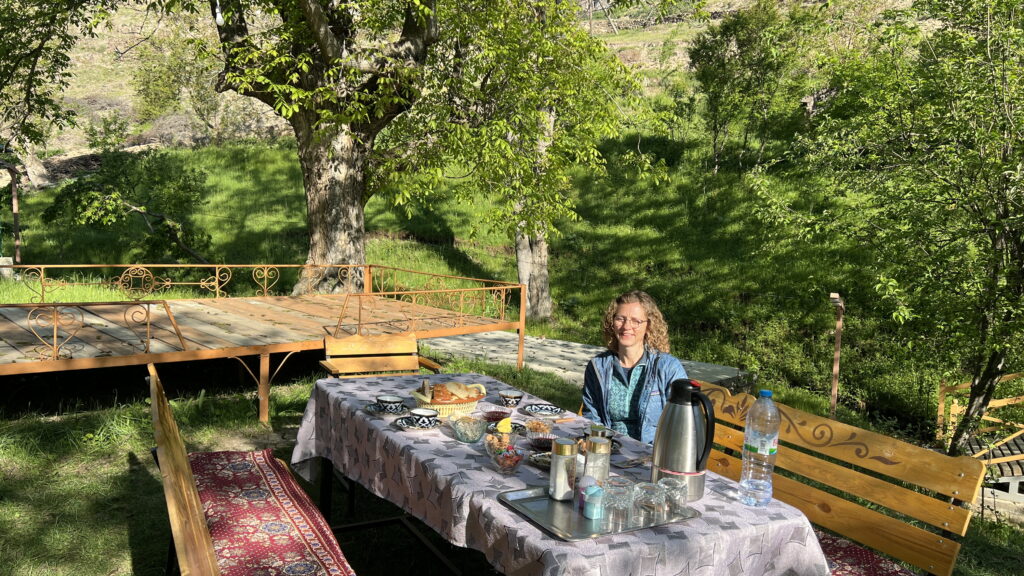
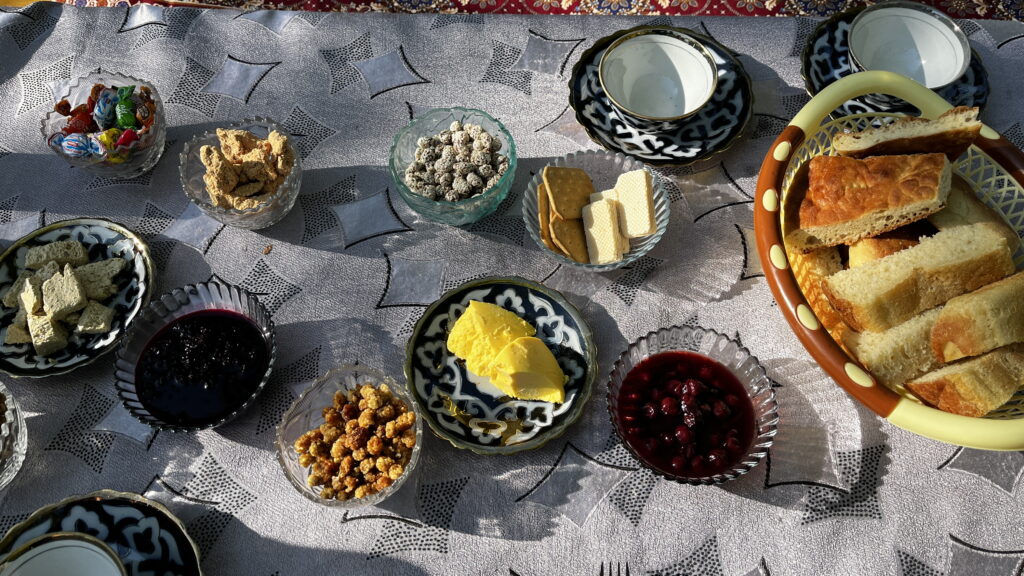
We met with our guide Dilmarod at the guest and hiked over the mountain to the next village Uhum. We continued up the valley to the Nuratau national park, where we saw ancient petroglyphs.
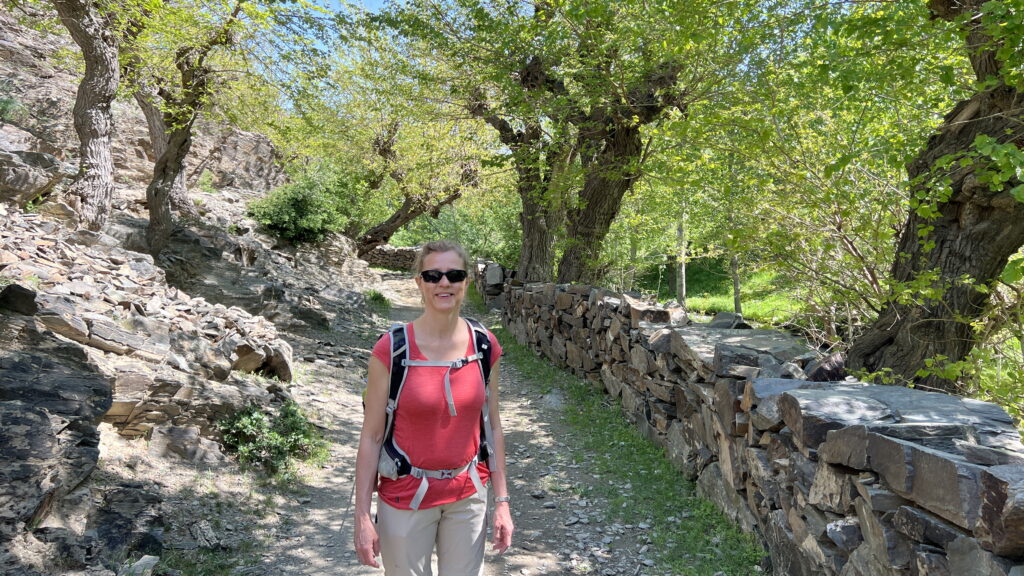
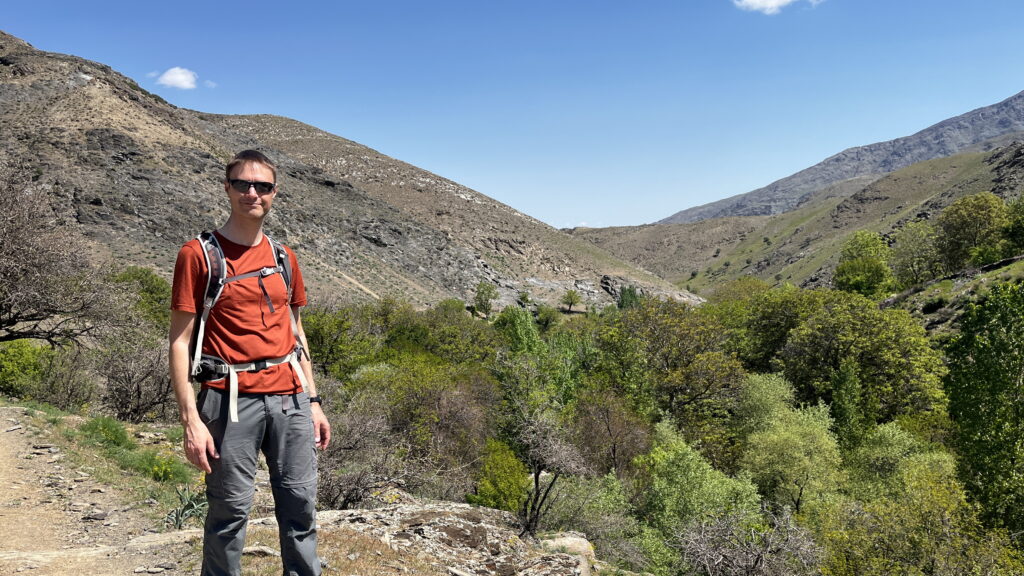
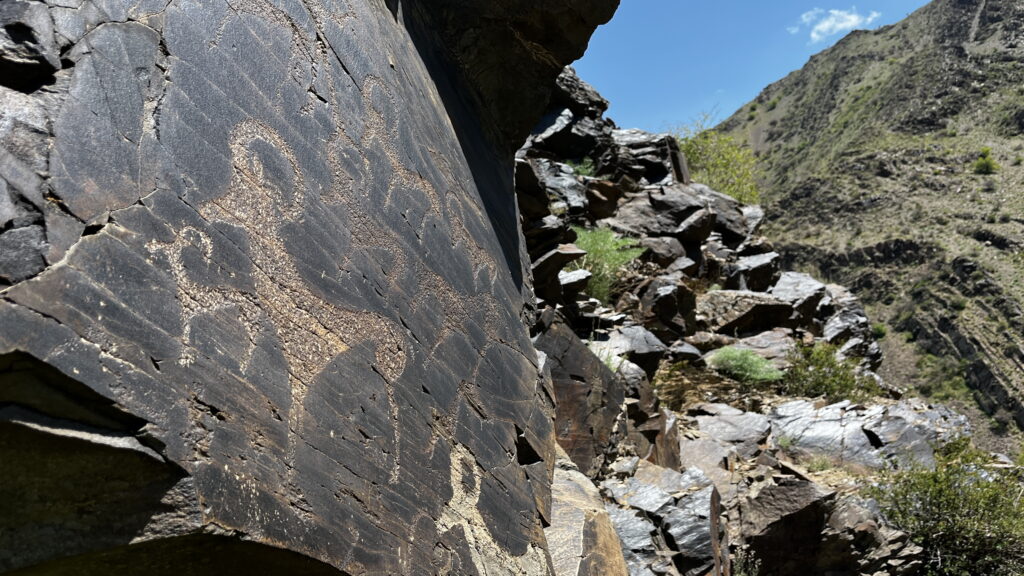

The landscape is varied with trees and green grass along the rivers and completely dry on the upper parts. There are 300 years old walnut trees and many fruit trees along the rivers.
We arrived at Ulug Bek Guesthouse in Uhum by lunch and had a traditional lunch with salads and plov (slowly cooked rice with vegetables and meat) together with our guide and a family member.

The people in the valley are originally from Tadsjikistan and they speak Tadjik, Uzbek and Russian. The young people also speak some English. They have 11 years of mandatory school, and the local school have 400 students and 40 teachers. Quite impressive in size compared to the remoteness of the villages. Dilmarod explained that the oldest sons usually stay in the village and inherent the family farm. He himself was not the oldest, but he preferred to live in the mountains, so he had opened a guesthouse, and made a living from tourism.
Day 7 – Hiking from Uhum to Asraf Village and driving to Samarkand
After a hearty breakfast we started our hike to Asraf through Uhum valley. The villagers have refined a system of irrigation channels for centuries, and the channels are still maintained and in use.

It was a beautiful hike on shepherd trails with views of Aydar Kol Lake in the distance and lots of fat tailed sheep, donkeys and cows.
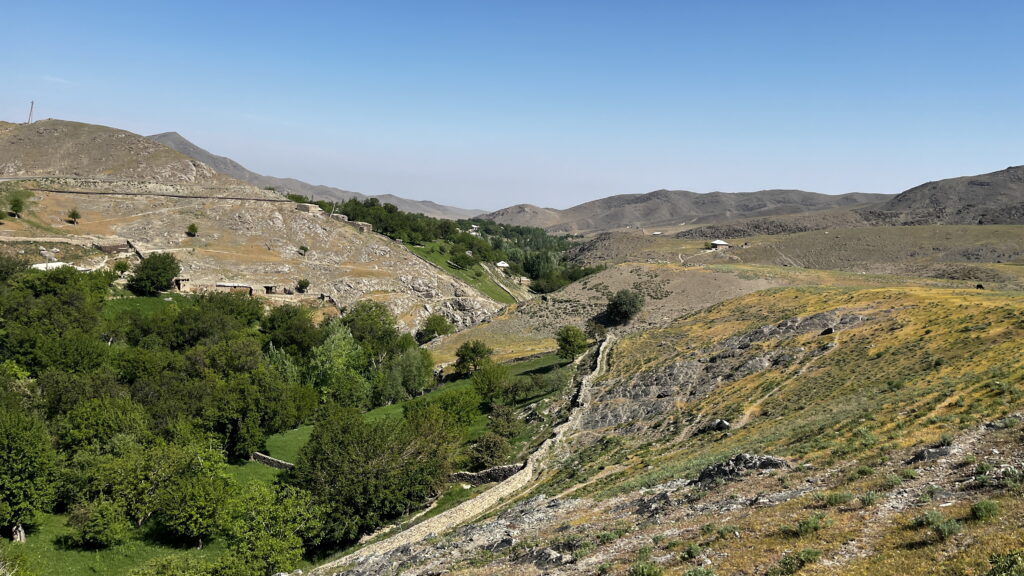


Dilmarod showed us a traditional water mill that was still in use for grinding flour.

We arrived at Asraf Village at noon and had lunch in the very beautiful garden of the guesthouse. We had great Uzbek food in the mountains and this lunch was no exception.

With stomachs full we started our return trip to Samarkand. We drove over the Nuratau mountains, where large parts of the road was in quite bad conditions. Luckily the Kia Sportage had good suspension. The route was very scenic compared to the otherwise flat steppe countryside.
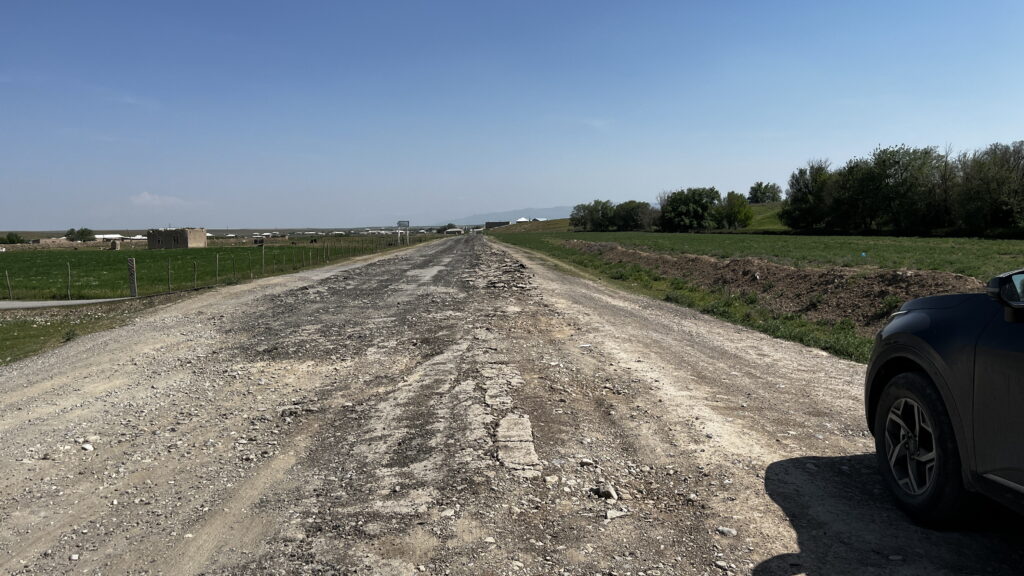
It was a huge contrast to get back to Samarkand with all the noise and people, but the city certainly has.
We checked into the charming Furkat guesthouse, where the rooms are organised around a courtyard with an ancient mulberry tree, and the city noise is not heard. The guesthouse could have been amazing, but the rooms smelled dusty and moldy to a point that it could be unhealthy.
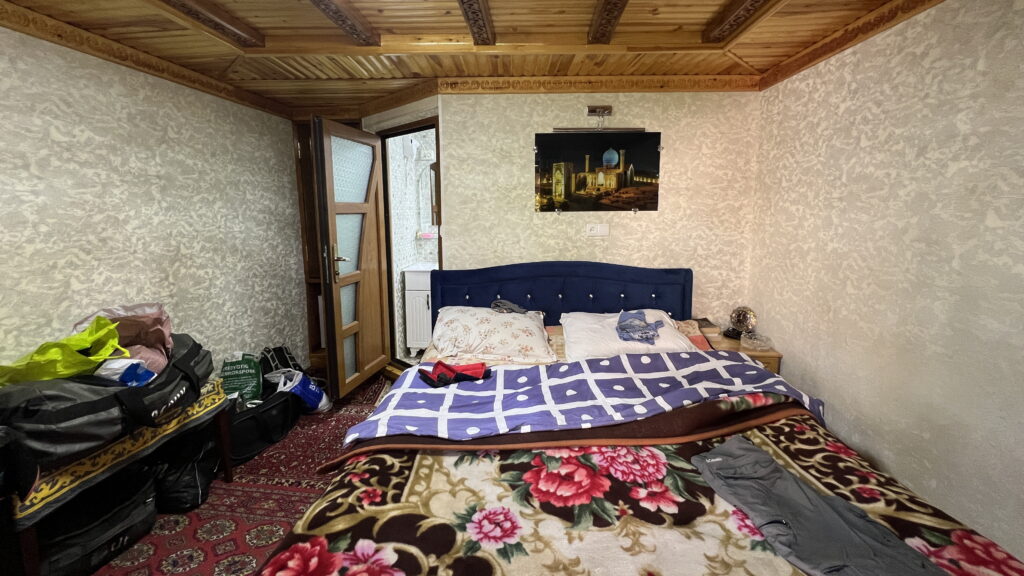
We went to the mausoleum complex Shah-i Zinda in the late afternoon. It’s monuments are beautifully decorated both on the outside and inside and again we were very impressed.
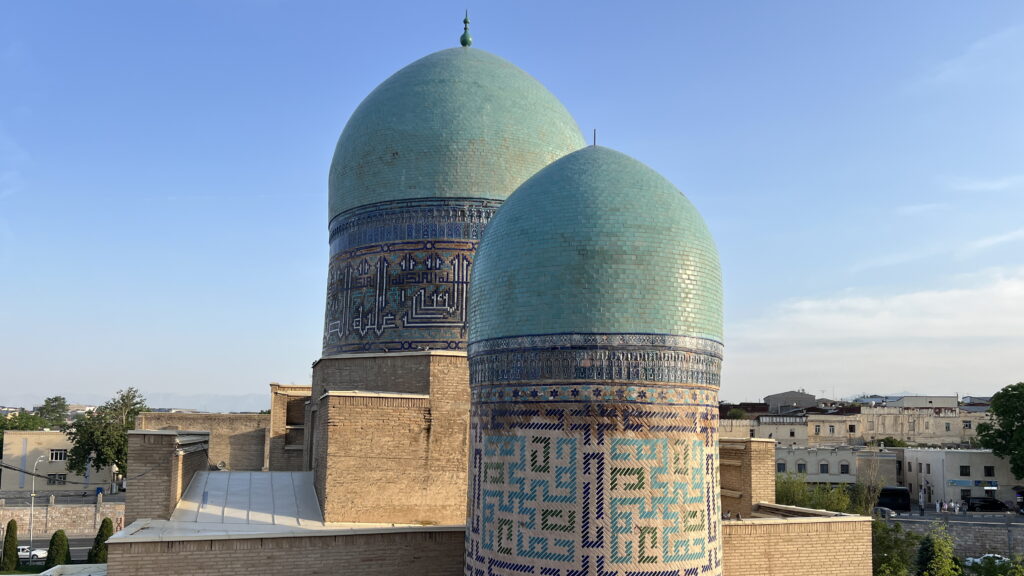




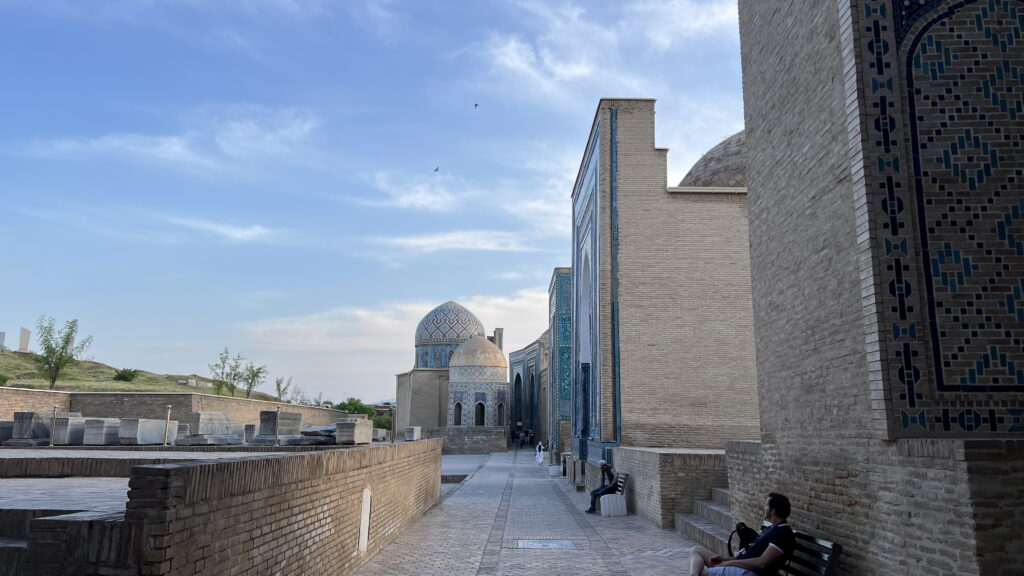
Day 8 – Amankutan Gorge Natural Preserve and Samarkand
Furkat guesthouse is in the city centre with narrow streets. We used Google Maps to navigate of of town, and were unintentionally led into a one-way street in the wrong direction during morning rush hour. We caused a traffic jam, and other drivers energetically pointed towards the camera that most likely had captured our offence.
After some maneuvering we managed to find a way out of time, and drove 50 km southeast of Samarkand to the mountains and the Amankutan Gorge Natural Preserve. We had found a hiking route on Maps.Me, but were stopped by a locked gate. We were lucky to arrive at the trailhead at the same time as a guide with a small group of Frenchmen. The guide knew how to call for the gatekeeper and shortly after the gatekeeper used a rock to unlock the gate with a skillful stroke.

We hiked up the gorge through forest and further up, where we got a sight of the snowcapped Fann Mountains in Tajikistan, igniting dreams of new adventures.
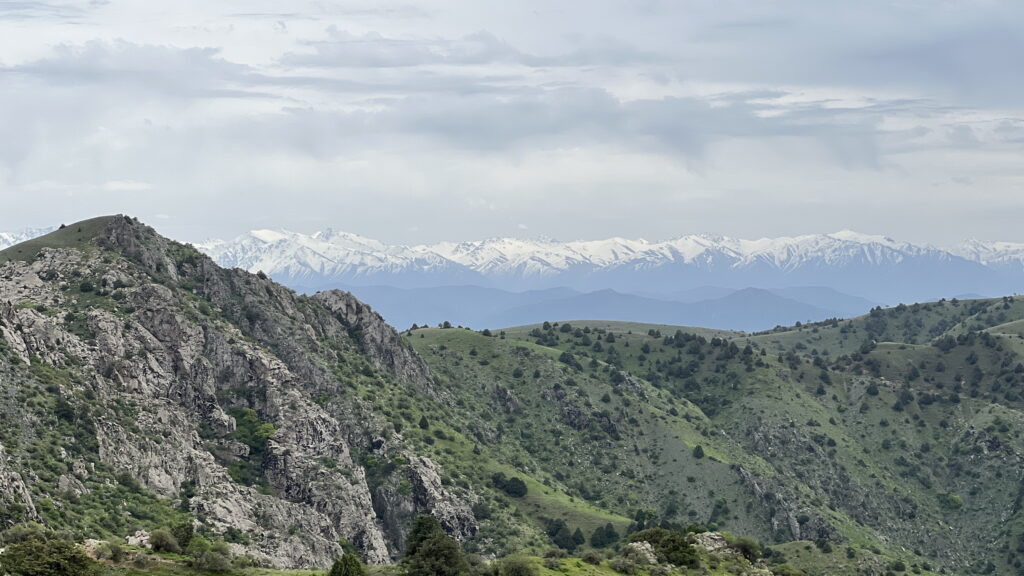
We saw lots of birds of prey and pretty flowers.
There was a roadside market at the pass, and we bought dried mulberries and chocolate pecan nuts. Many also sold fresh rhubarb.

Back in Samarkand we visited the Ulug Bek Observatory, where the only remaining structure is part of his quadrant arch (63 m in length) that was used to determine the movements of the stars and formed the basics of calculating the length of a year.
In the other end of the city we visited the Gur-i Amir from 1404, which serves at the mausoleum for the Timur dynasty. Both Timur and his grandson Ulug Bek is said to be buried here. The inside was almost completely covered by gold and beautifully decorated.

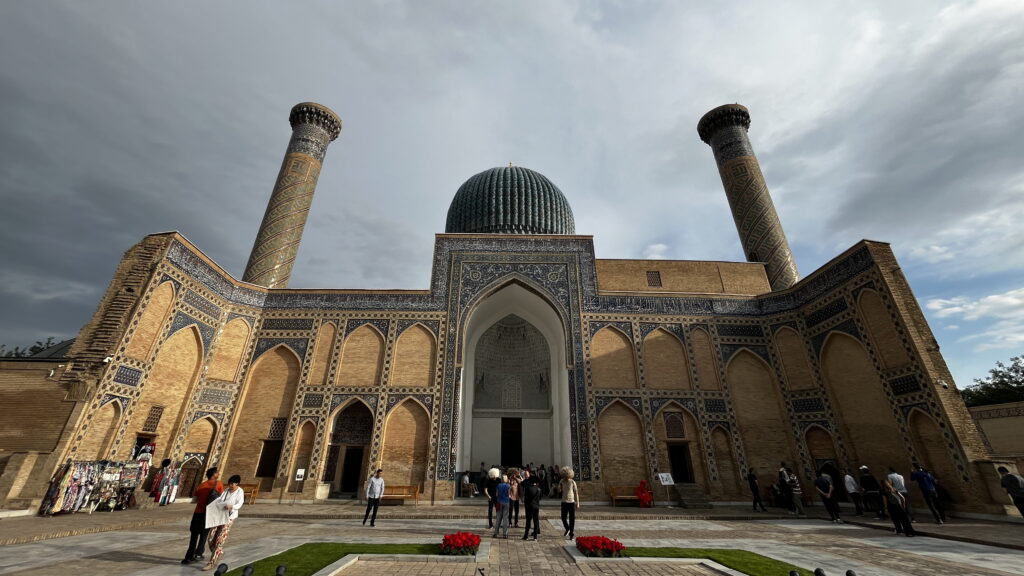

We enjoyed the last traditional Uzbek meal in the outdoor courtyard of the Bibikhanum restaurant, and had a great meal in pleasant summer temperatures.
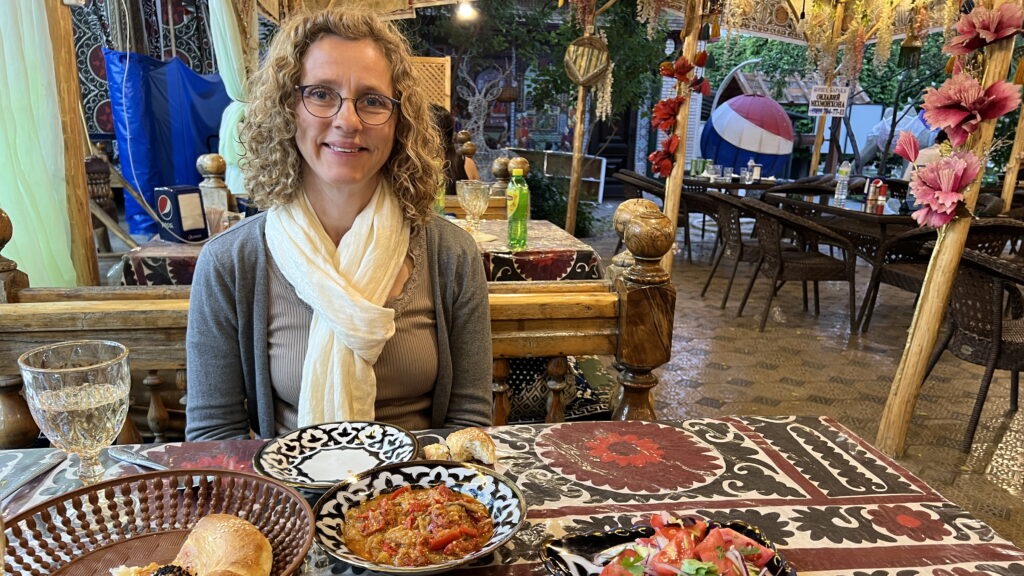
The following morning we met Roland from Sixt at 4:00, returned the car, and checked in to our flight.
Vegetarians in Uzbekistan
When people think of Uzbek cuisine, hearty platters of meat-heavy plov and skewers of shashlik often come to mind. As vegetarians, we expected challenges, but instead we surprised how welcoming and accommodating the country would be when it came to vegetarian fare.
Some of the memorable vegetarian-friendly dishes we tried included:
- Gulxanam – Red dumplings with seasoned vegetables
- Manti – A delicious fried samosa-style dish, stuffed with spinach
- Felfel – Stuffed bell peppers, spicy and satisfying
- Samsa – Oven-baked dough pockets with vegetable fillings
- Plov – While traditionally a meat dish, we encountered vegetarian versions featuring fragrant rice and vegetables
- Baklava – the signature Turkish pastry is also popular in Uzbekistan
After meals, we were often offered dried fruits and nuts—dried mulberries, walnuts, sugar-coated peanuts, and almonds.


Though restaurants in cities sometimes offered fewer options, the guesthouses more than made up for it with fresh ingredients and true hospitality. Culinary exploration wasn’t our main goal—but Uzbekistan delivered in ways we hadn’t imagined.
